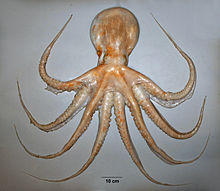
Oegopsida is one of the two orders of squid in the superorder Decapodiformes, in the class Cephalopoda. Together with the Myopsina, it was formerly considered to be a suborder of the order Teuthida, in which case it was known as Oegopsina. This reclassification is due to Oegopsina and Myopsina not being demonstrated to form a clade.

Myopsida is one of the four orders of squid. It consists of two families: the monotypic Australiteuthis and the diverse and commercially important Loliginidae. Some taxonomists classify this taxon as a suborder of the order Teuthida, in which case it is known as Myopsina. This reclassification is due to Myopsina and Oegopsina not being demonstrated to form a clade.

Cirrina or Cirrata is a suborder and one of the two main divisions of octopuses. Cirrate octopuses have a small, internal shell and two fins on their head, while their sister suborder Incirrina has neither. The fins of cirrate octopods are associated with a unique cartilage-like shell in a shell sac. In cross-section, the fins have distinct proximal and distal regions, both of which are covered by a thin surface sheath of muscle.
Obinautilus is an extinct genus of shelled cephalopod that has been variously identified as an argonautid octopod or a nautilid. It is known from the Late Oligocene to Pliocene of Japan. The shell is discoidal and very involute, with rapidly expanding and compressed whorls, fine radial ribs, a rounded venter with a shallow furrow, and almost closed umbilicus.
Idiosepiidae is a family of mollusk in the class Cephalopoda. This family appears to be related to the cuttlefish in the order Sepiida and the bobtail squid in the order Sepiolida but the exact placement of this family within the Decapodiformes is incertae sedis.
Xipholeptos notoides, commonly known as the southern pygmy squid, is the sole species in the cephalopod genus Xipholeptos. The species was originally classified as Idiosepius notoides. The southern pygmy squid is native to the southwestern Pacific Ocean, off southern and eastern Australia. It inhabits shallow, inshore waters. It has been recorded off the coasts of New South Wales, South Australia, Tasmania and Victoria.

Bathypolypus is a genus of octopuses in the monotypic family Bathypolypodidae. It has five described species.

Pareledone is a genus of octopuses in the family Megaleledonidae.
Thaumeledone is a genus of octopuses in the family Octopodidae found in deep waters in the Southern Hemisphere.

Muusoctopus levis is a species of octopus in the family Enteroctopodidae. It was first described by William Evans Hoyle in 1885 in an article in the Annals and Magazine of Natural History detailing the new species of octopus found on HMS Challenger as part of the Challenger expedition; the type specimen was retrieved from the Southern Ocean. The species is found in subantarctic waters in the Southern Ocean, particularly surrounding Heard Island and Kerguelen Island, but specimens comparable to M. levis have also been found at the Antarctic Peninsula.
Thaumeledone gunteri is a species of small, benthic, deep-sea octopus found in the bathyal zone in the Southern Ocean near South Georgia.

Octopodoidea is a superfamily of the suborder Incirrata containing all octopods except for the argonauts and the vampire squid.

Jan Maree Strugnell is an Australian evolutionary molecular biologist. She is an associate professor and director in the Centre for Sustainable Tropical Fisheries and Aquaculture at James Cook University, Townsville, Australia. Strugnell's work has investigated population and species level molecular evolution in Antarctic and deep sea species in the context of past geological and climatic change. Strugnell's work also uses genetic tools to help solve bottlenecks in aquaculture and fisheries industries.

Louise Allcock is a British researcher, best known for her work on ecology and evolution of the cephalopods of the Southern Ocean and deep sea. She is the editor of the Zoological Journal of the Linnean Society.

Megaleledonidae is a family of octopuses in the superfamily Octopodoidea. It was formerly placed in the family Octopodidae sensu lato as the subfamily Megaleledoninae but more recent studies have raised this taxon as a valid family.

Muusoctopus is a cosmopolitan genus of deep-sea octopus from the family Enteroctopodidae. These are small to medium-sized octopuses which lack an ink sac. Recent work has suggested that these octopuses originated in the North Atlantic and subsequently moved into the North Pacific while the species in the Southern Hemisphere are descended from multiple invasions from northern oceans.
Sasakiopus is a genus of octopus containing only one species, Sasakiopus salebrosus, the rough octopus. It is part of the family Enteroctopodidae. Genetic analysis appeared to show that S. salebrosus is the sister taxon of the genera Benthoctopus and Vulcanoctopus, although the former is now considered a synonym of Bathypolypus, the only genus in the family Bathypolypodidae, and the latter as a synonym of Muusoctopus.

Sepioloidea lineolata or more commonly known as the striped pyjama squid or the striped dumpling squid is a type of cuttlefish that inhabits the Indo-Pacific Oceans of Australia. The striped pyjama squid lives on the seafloor and is both venomous and poisonous. When fully mature, a striped pyjama squid will only be about 7 to 8 centimeters in length.
Opisthoteuthis borealis is a lesser-known species of octopus found near Greenland and Iceland, especially in the Davis Strait. The species was described from 9 specimens, and is one of the most recent Opisthoteuthis species described. Not much is known about it besides its anatomy and habitat.
Opisthoteuths hardyi is a lesser-known octopus species. It was described in 2002 from a male caught off the Shag Rocks, which are far south in the Atlantic Ocean near the Falkland Islands.











